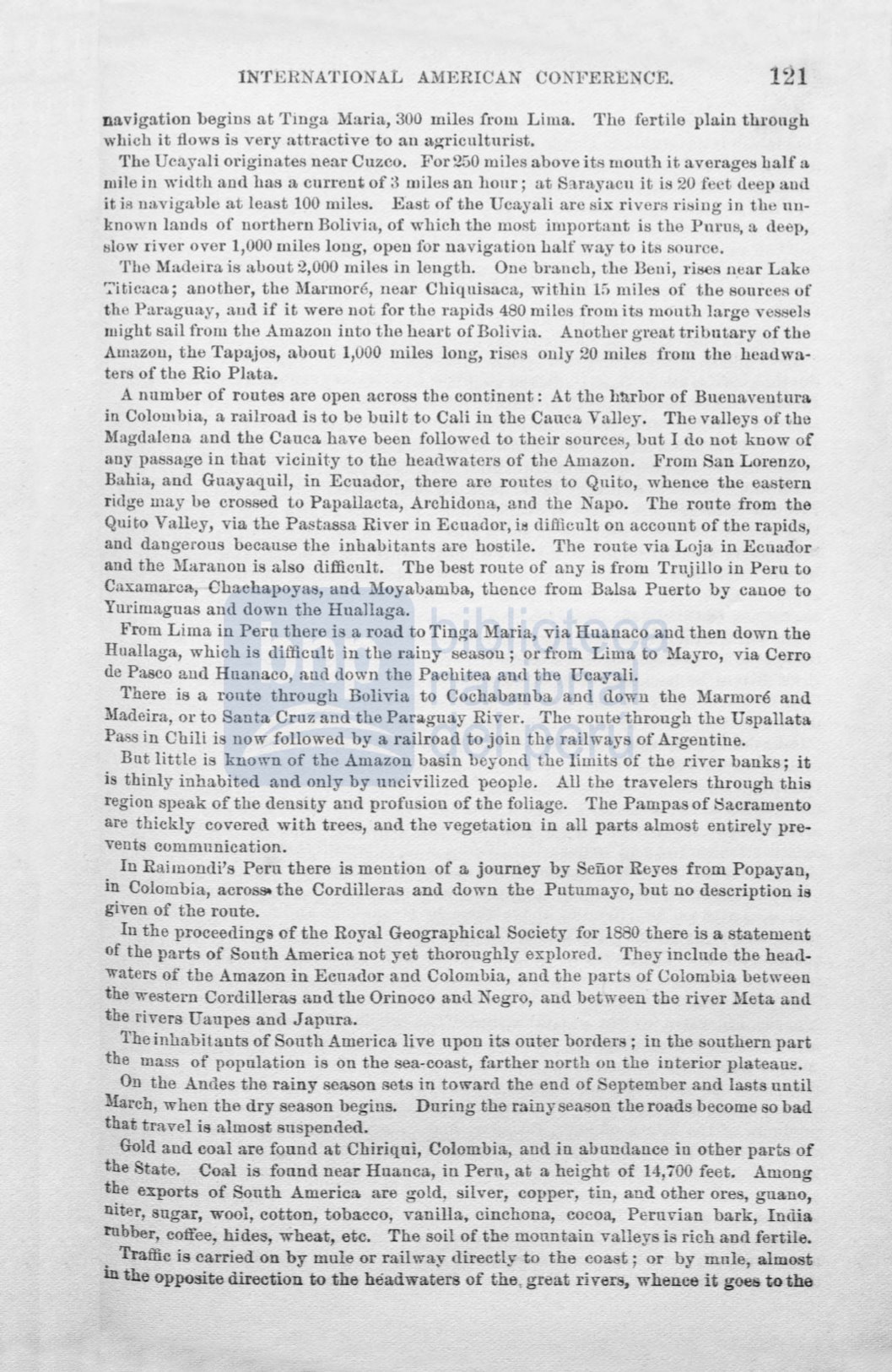

1NTER.~.
A.TIO A.t. AMERICAN CONli'ERENCE.
121
navign.tion begins at Tinga Maria, 300 miles írom Lima. The fertile plain throngh
which it flows is very n.ttractive to au agricultnrist.
The Ucayali originates near Cuzco. For250 miles aboveits mouth it averageíl balf a
mile in ·width and has a cnrrent of 3 miles an hour; at Sn.rayacu it is 20 feet deep aud
it
is navigaule at least 100 miles. East of the Ucayali aro six rivera rü!ing in tbe nn–
known lands of uorthern Bolivia, of wbich the ruost important is tbe Purns, a deep,
slow rivor over 1,000 miles long, open for navigatiou half way to
it
source.
Tbe Madeira is about 2,000 miles in lengtb. One bra.uch, the Beni, rise near Lake
':'iticaca; another, the Marmoré, near Chiquisaca, withiu 1!""> mile of the sources of
tbe Paraguay, aud if it were not for the rapids 480 milos ft·om its mouth large vessel;;
might sail from the Amazon into the heart ofBolivia. Auother great trilmtary of the
Amazon, the Tapajos, about 1,000 miles long, 1·ises only 20 miles fmm the headwa–
ters of the Rio Plata.
A number of routes are open across the continent: At the b!l.rbor of Buenaventura.
in Colombia, a railroad is to be buil t to Cali in tbe Cauca Valley. Tbe valleys of the
Magdalena and the Canea have been followed to their sources, uut I do not know of
any passage in that vicinity to the headwaters of the Amazon. From San Lorenzo,
Babia, and Guayaquil, in Ecuador, tbere aro routes to Quito, whence the eastern
ridge may be crossed to Papallacta, Archidoua, and the Napo. The route from the
Quito V!tlley, via the Pastassa River in Ecuador,
it~
difficult on account of the rapids,
and dangerons because the inbabltant.s are hostile. The route via Loja in Ecuador
and the Maranon is also difficult. The best route of uny is froru Trnjillo in Peru to
Caxamarca, Chachapoyas, and Moyauamba, thence from Balsa Puerto by canoe to
Yurimagua and dowu the Hua1laga.
From Lima in Peru there is a road to Tinga Maria, vía Huanaco aud then down the
Huallaga, which is difficult in the rainy season; or from Lima to Mayro, vía Cerro
de Paseo and
Hnana.co,aud down the Pachitea and the Ucayali.
There is a ronte through Bolivia to Cochabamba and down the Marmoré and
Madeira, orto Santa Cruz and the Para,guay River. The ronte through the Uspallata
Pass in Cbili is now followed by a railroad to join the railways of Argentino.
But little is known of the Amazon basin beyond the limits of the river banks; it
is tbinly inhabited and only by uncivilized people. All the travelers through this
region speak of the density and profusion of the foliage. The Pampas of ::;acramento
are thickly coverecl. with trees, and the vegetation in all parts almost entirely pre–
vents communication.
In Raimondi's Peru there
is
mention of
a.
journey by Señor Reyes from Popayan,
in Colombia, across- the Cordilleras and down tbe Putumayo, but no description is
given of the ronte.
In the proceedings of the Royal Geographical Society for 1880 there
is
a statement
of the parts of South America not yet thoroughly explored. Tbey inclnde the head–
waters of tbe Amazon in Ecnl\dor and Colombia, and the parts of Colombia betweeu
the western Cordilleras and the Orinoco and Negro, and between the river Meta and
the rivera Uaupes and Japura.
The inhabilants of South America live upon its outer borders; in the outhern part
the mass of population is on the sea-coast, farther north ou the interior plateaue.
On the Andes the rainy soa.son sets in toward the eud of eptember and lasta nntil
March,
w
hen the dry season begius. During the rainy sea on the roads become sobad
that travel is almost suspended.
Gold and coal are found at Chiriqui, Colombia, and in a.bundance in otber part of
the State. Coal is found near Hnanca, in Pern, a.t a height of 14,700 feet. Among
the exporta of Sonth America are o·old, silver, copper, tin, and other ore , guano,
niter, sugar, wool, cotton, tobacco, vanilla, cinchona, cocoa, Peruvian bark, Incüa
:rubber, cotfee, hides, wheat, etc. The soil of tbe monntain valle
y
iB
rich and fertile.
. Traffic is carried on by mule or raílway directly to the coa t · or by mule, almost
m the opposite direction
to
the héadwaters of the, great river
,
whence it goes to t he
















